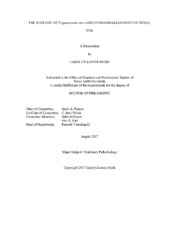| dc.description.abstract | Trypanosoma cruzi, agent of Chagas disease, is a zoonotic vector-borne protozoan that infects mammalian hosts throughout the Americas. Spillover from sylvatic cycles occurs when triatomine vectors bridge the parasite from wildlife to humans, dogs, or captive NHPs. Although knowledge of reservoir capacity of diverse wildlife could provide an ecological basis for disease management, most wildlife studies document exposure with little attention to infectiousness to vectors. Additionally, pathology investigations can provide key information on pathogenesis and population impacts.
To investigate T. cruzi infection prevalence, strain types, and risk factors in dogs, we collected blood from 611 dogs at shelters across Texas. 18.2% of dogs were seropositive for T. cruzi. Six (1.1%) dogs harbored parasite DNA in their blood, of which 5 were DTU TcI and 1 was TcIV.
To determine the trypanosome prevalence in Texas bats, we collected hearts and blood from bats across Texas. Of 593 bats, 1 was positive for T. cruzi (0.17%), 9 for T. dionisii (1.5%), and 5 for Blastocrithidia spp. (0.8%), a group of insect trypanosomes. The T. cruzi-infected bat was carrying TcI. In the T. dionisii-infected bats, we detected three unique variants associated with the three infected bat species.
To characterize the T. cruzi reservoir status and associated pathology in coyotes and raccoons in Texas, we collected hearts and/or blood from animals in Central and South Texas. Infection prevalence was greater in raccoons (66.7%) than coyotes (7.5%; Z=-6.8, PCR- positive coyotes exhibiting mild to moderate lymphoplasmacytic inflammation and occasional myodegeneration and fibrosis. In contrast, raccoons had only very mild inflammation. At a NHP facility in San Antonio, we tested 145 rats for T. cruzi infection and found no positives. Limited vector surveillance yielded no kissing bugs.
At a NHP facility in Bastrop, we tested blood from NHPs, trapped free-ranging wild mammals, and collected kissing bugs. 80% of NHPs were PCR-positive, though parasite concentrations were low and intermittent. Raccoons, opossums, and skunks were highly infected with T. cruzi, while rodents were uninfected. Few kissing bugs were collected, but most were from a building very close to NHP housing. | en |


